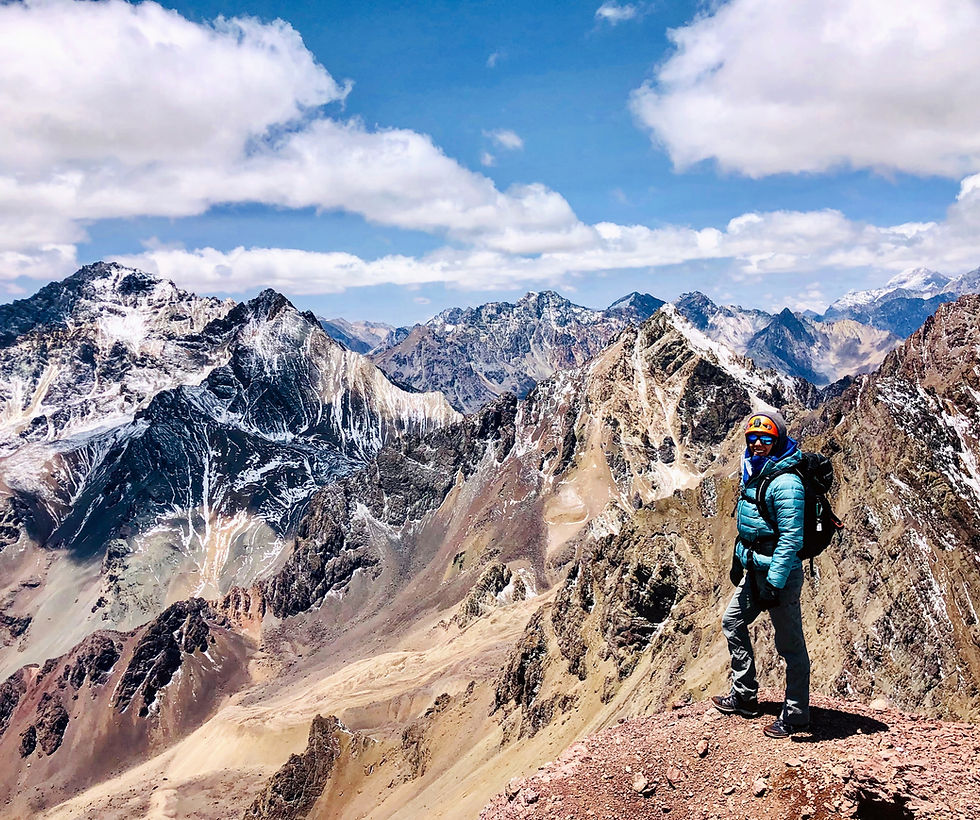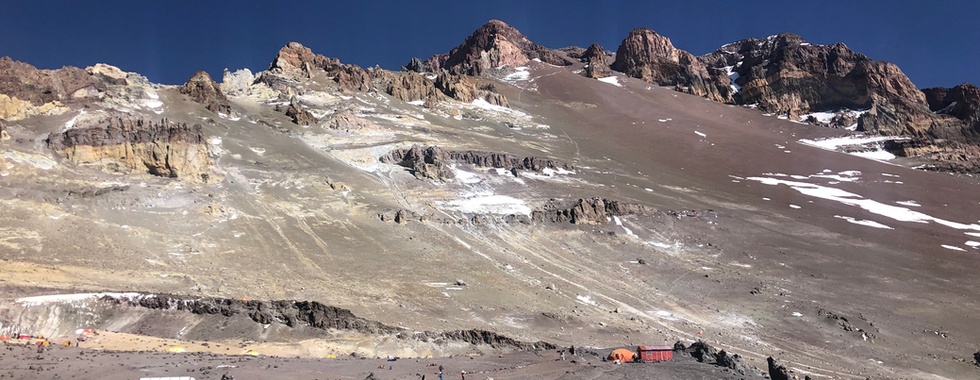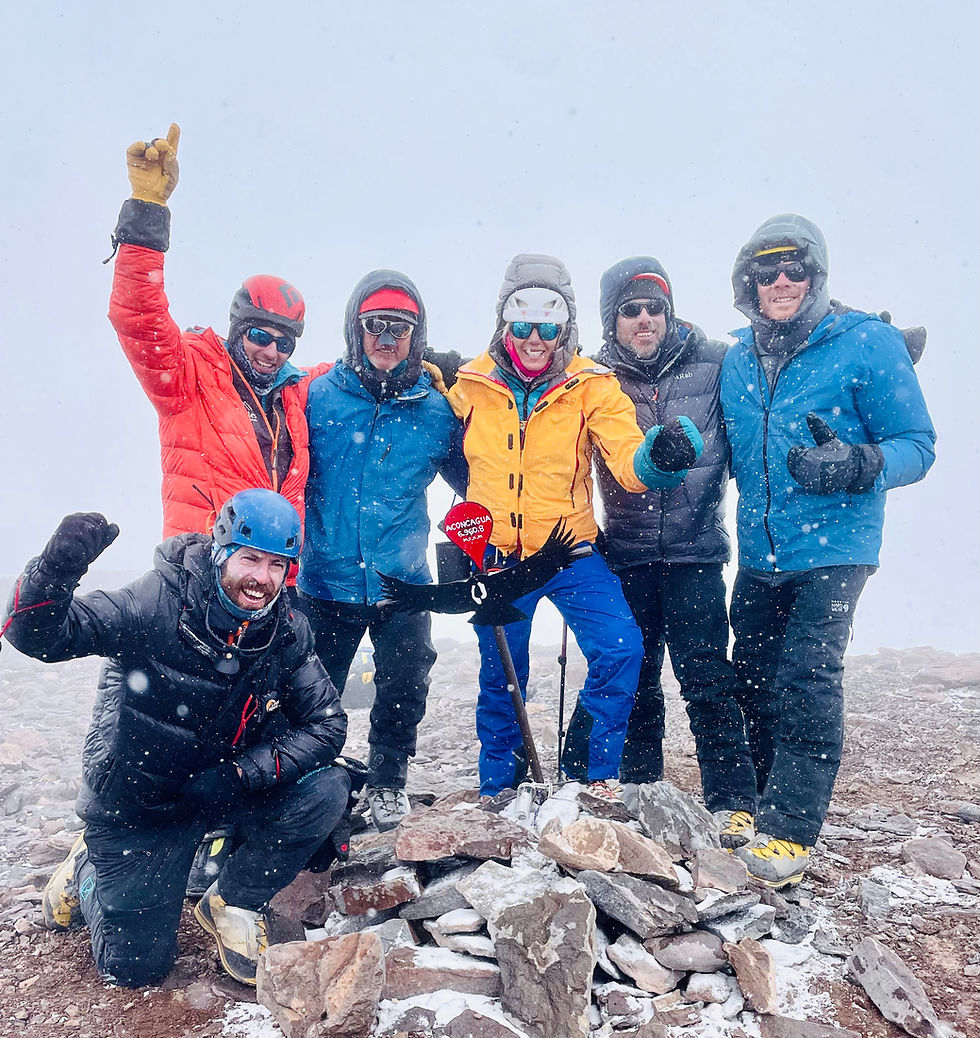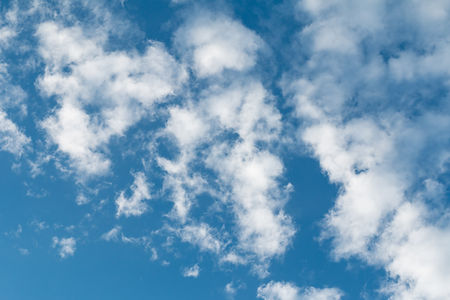Want to Climb Aconcagua? My Top 5 Tips
- Mia Farrow

- Jun 20
- 7 min read
Updated: Jun 26
Embarking on the thrilling journey of summiting challenging mountain peaks is a dream for many outdoor enthusiasts. The awe-inspiring views and the sense of accomplishment that come with reaching the top make it a truly exhilarating experience.
Aconcagua in Argentina is the tallest mountain in the world outside of Asia. It is the one of the 7 Summits (Mount Everest, Aconcagua, Kilimanjaro, Elbrus, Denali, Kosciuszko and Vinson; according to Richard Bass.).
And climbing Aconcagua at 6961 metres (22838 feet) is a unique and memorable experience.

However, climbing challenging mountain peaks requires thorough preparation and a good understanding of the risks involved.
Aconcagua is typically climbed November to March and it takes 10 - 21 days, depending on the route and one's fitness level.
Having climbed Aconcagua three times and spending considerable time on this breathtaking mountain, I have assisted other like-minded individuals in successfully climbing Aconcagua.
Here are some insights and my top 5 tips to help make your mountain dreams a reality:
(assuming Mother Nature is on your side)
PHYSICAL PREPARATION
RESEARCH & PLANNING: CHOOSE THE RIGHT COMPANY
SAFETY / GEAR
PRE-ACCLIMATISATION
MINDSET
PHYSICAL PREPARATION
Before setting out on your mountain adventure, it's critical to ensure that you are in peak physical condition. Training your cardiovascular endurance, strength, and flexibility is essential to tackle the demanding terrain. Aconcagua has one of the longest approaches to Base camps and high camps.
It is strongly recommended to begin your physical preparation well ahead of time, ideally 9-12 months prior to the trip.
This involves planning for:
#1 Strength and Cardio routine
#2 Health screening
#3 Breathing protocols
#1 As far as physical prep, hiring a personal trainer can be advantageous, especially if you have a busy schedule. Personal coaches offer great benefits by ensuring correct form and keeping you accountable. They also take the mental part out of the equation (so you can use that energy on other things like work or home life) and they can progress you better.
If personal trainers are not an option, try looking for a Strength & Conditioning Plan to follow. Companies like Uphill Athlete provide excellent and reliable plans for high-altitude activities. They also offer numerous articles and insight into the challenges of high-altitude. Highly recommend. Uphill Athlete link
I have personally worked with Martin Zhor, from the Uphill Athlete, for my 2024 preparation link here and have had a friend use their standard strength training program, and both of us had successful summit experience.
You can also check out my blog post: "My prep with Conor for my Aconcagua360 speed ascent." In my blog, I emphasise the importance of balance training, single-leg strength, core, and back, along with undertaking multi-day loaded hikes to get accustomed to the long approach on Aconcagua.
StrongFirst and Adventure Fit, coach Derek Toshner, has developed plans to get you fit for all types of adventures, check out my blog post and reach out to Derek.
Derek leads and coaches for 29029 Everesting events. blog post
#2 Consulting with your local GP or a doctor about getting a standardised blood test or a basic health screen is highly recommended before you sign up for big expeditions.
I strongly suggest checking your iron levels, total red blood cells, haemoglobin, hormones, etc. before starting your training, during your training, and even before departing for Argentina. Your age and training intensity can influence these levels, even during demanding endurance sessions.
At high altitudes, where oxygen levels are lower, red blood cells become crucial for carrying oxygen to the body's tissues.
If you are anaemic, this condition can take some time to improve.
However, increased iron level, also known as iron overload or hemochrombtosis, can lead to serious health problems if not addressed.
Consulting with your doctor is important.
Uphill Athlete offers several articles and podcasts on this topic, it's worth a read / listen.
Hydration is another critical component that should be trained. At certain high altitudes, you will be drinking as much as five litres of fluids each day. In addition to your physical preparation, proper Hydration is key to avoiding altitude sickness. Train for it.
Please take this into consideration and start planning. Investing your time in thorough preparation will enhance your chances of success.
#3 Breathing protocols
The higher you go, the thinner the air gets (barometric pressure decreases). With less oxygen available, your body has to work overtime to deliver the oxygen your muscles and organs need. This can lead to symptoms like shortness of breath, rapid breathing, fatigue, and decreased performance. Proper breathing is important at high altitudes to help the body adapt to these lower oxygen levels in the air.
RESEARCH & PLANNING: CHOOSE THE RIGHT COMPANY
Thorough research and meticulous planning are key to a successful summit attempt. Study the route, understand the challenges you may face, and familiarise yourself with the weather conditions of the mountain. Create a detailed itinerary, including contingency plans for unforeseen circumstances. Familiarise yourself with the necessary gear and equipment required for the climb.
Whether you are planning to go solo, or as part of a group (unassisted or assisted) - it is a good idea to use logistical support from one of the operating companies on Aconcagua. Think: safety! and then do your research.
"Good company in a journey makes the way seem shorter"
I highly recommend Grajales Expeditions who pioneered logistical support on Aconcagua. Fernando Grajales: (borrowed from their website):
"Back in 1954, Fernando Grajales played a key role in the first Latin American expedition to the Himalaya. By then, he had already opened one of the first technical routes on Mt. Aconcagua. Twenty years later, the Mendocino climber also became a pioneer in the mountain business.
Grajales Expeditions, the small guiding company he founded, was granted the first official license to operate in Aconcagua. (In 1976, years before the mountain was protected by a State Park).
45 years have gone by, and we at Grajales Expeditions keep trying to follow Fernando’s lead, his love of nature and his clear, optimistic views. We are so proud of this legacy that we even published a book about his life: Breaking Trail on Aconcagua. We are now publishing the book as a free download, hoping to deliver a positive message in these times of global uncertainty."
I have been part of two successful expeditions with Grajales Expeditions and completed a personal project on Aconcagua, which I featured in one of my blog posts. blog posts
Cumbres Magazine published an article recently highlighting Grajales: link
ACCLIMATISATION
Acclimatising to high altitudes is critical when climbing challenging mountain peaks. Gradually ascending to higher elevations allows your body to adapt to the decrease in oxygen levels, reducing the risk of altitude sickness.
Take your time to acclimate properly, stay hydrated, and listen to your body's signals. If you experience symptoms of altitude sickness, descend to a lower altitude immediately.
For hydration, I suggest adding electrolytes and minerals to 'diluted' mountain water. Melted snow lacks any nutrients.
If you have extra days, I highly recommend visiting a nearby refuge called Portezuelo del Viento in Las Cuevas for pre-acclimatisation before attempting Aconcagua. It's also a good idea to spend time there to recover from jet-lag.
Portezuelo del Viento is situated at 3200m, and you can explore nearby peaks reaching up to 4500m, like Santa Elena, as part of your pre-acclimatisation process.
Portezuelo del Viento is situated approximately 4 hours from Mendoza, en route to Aconcagua. The local bus fare is $15 USD. You can also look into flying to Santiago Chile and hiring a car or taking a bus to Las Cuevas. Blog post
Reach out to Magali on Whatsapp: +54 9 2612 52-5097 or via email: contacto@portezuelodelviento.com
SAFETY / GEAR
Safety should always be your top priority when climbing challenging mountain peaks.
Be prepared for emergencies by carrying a first aid kit, satellite communication devices, and navigation tools.
Familiarise yourself with basic mountaineering techniques - such as rope and harness use, and practice proper safety protocols.
For Aussies, check out my blog there are local companies you can use to learn all about safety on the mountain.
Make sure to thoroughly review the gear list provided by the company you are climbing with, and inquire about any equipment you might be able to rent in Mendoza instead of bringing it on your flight to Argentina. This can lead to significant cost savings.
If you are climbing solo: always check the weather forecast before embarking on your climb, and be prepared to turn back if conditions deteriorate (mountain-forecast.com)
MINDSET
Summiting challenging mountain peaks requires mental resilience and unwavering determination. Stay focused, stay positive, and stay motivated even when faced with obstacles along the way. Most importantly, stay prepared. Your physical strength significantly influences your mental state, particularly at high altitudes where cognitive function may be impaired.
Engaging in progressive strength training or muscle endurance exercises is extremely advantageous for mental conditioning too. These activities frequently challenge you, helping to train your mind to persevere through uncomfortable situations while on the mountain.
Listen to your body, know your limits, and don't hesitate to turn back if the conditions become too dangerous. Remember, reaching the summit is an achievement, but ensuring your safety is paramount. "Getting to the top is optional - getting down is mandatory." Ed Viesturs
Some of the books I highly recommend are: Win the Inside Game by Steve Magness, Atomic Habits by James Clear, Play On by Jeff Bercovici, etc.
As you prepare to conquer those daunting mountain peaks, remember that the journey is as important as the destination. The sense of camaraderie among climbers and the support from guides and fellow adventurers can create bonds that last a lifetime. Each ascent is not just about reaching the peak; it’s about the shared experiences, the stories exchanged around campfires, and the lessons learned in the face of nature’s grandeur.
Try to enjoy every moment of your mountain adventure.
Invest your time and resources into preparation, choose the right company and go confidently in the direction of your goals. With the right mindset and meticulous preparation, you can turn your mountain dreams into reality.
Climb On!


























Comments